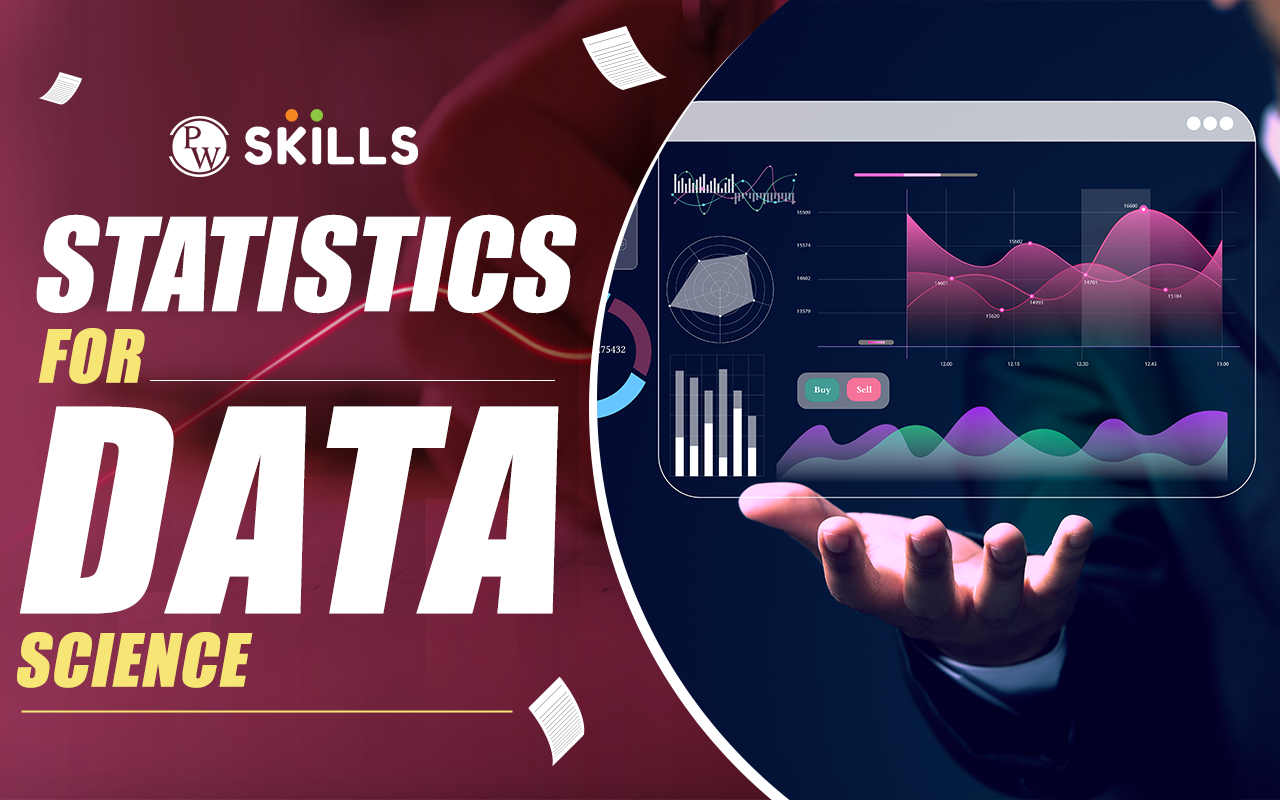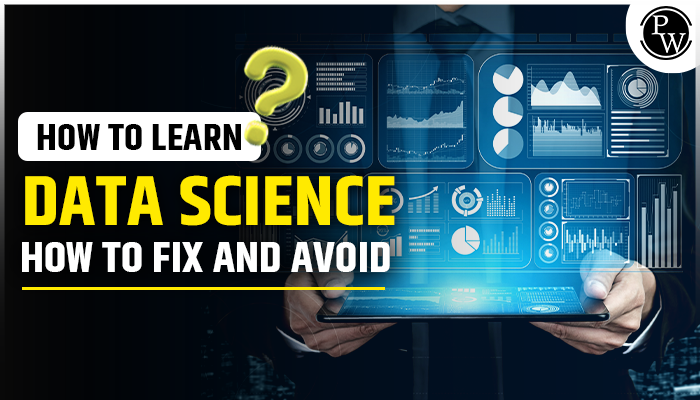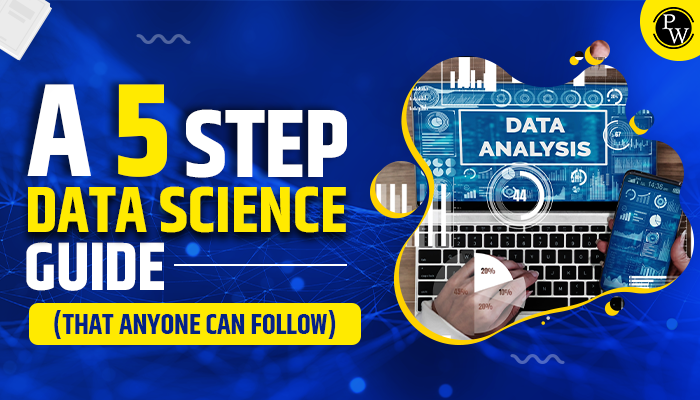Statistics for Data Science: Statistics is important for Data Science because it helps make sense of big data. It helps us understand and trust the information we get from all the numbers, making it easier to make smart decisions. In the ever-evolving landscape of data science, statistics plays a pivotal role, serving as the backbone for informed decision-making and insightful data analysis. As organisations harness the power of data to gain a competitive edge, a solid understanding of statistical concepts becomes increasingly crucial for data scientists. In this blog, we’ll talk about the importance of statistics for data science and much more!

Importance of Statistics for Data Science
Here are some strong reasons why statistics for data science is important:
Foundation for Informed Decision-Making
At its core, data science revolves around extracting meaningful insights from raw data to guide decision-making. Statistics provides the tools and techniques necessary to analyse data, identify patterns, and draw valid conclusions. Whether it’s determining the effectiveness of a marketing campaign or optimising supply chain operations, a statistical mindset is essential for making informed choices backed by robust evidence.
Key Role in Data Exploration and Visualization
Data exploration is a crucial phase in any data science project. Statistics empowers data scientists to explore datasets, uncover hidden trends, and visualise patterns effectively. Descriptive statistics, such as mean, median, and standard deviation, offer a snapshot of the data’s central tendencies and variations, aiding in the creation of compelling visualisations that communicate complex information in a digestible format.
Enabling Predictive Modelling and Machine Learning
Predictive modelling and machine learning are integral components of advanced data science applications. Statistical techniques, particularly regression analysis, play a vital role in building predictive models. By understanding the relationships between variables and making predictions based on historical data, data scientists can develop models that forecast future trends and outcomes, from predicting customer behaviour to optimising business processes.
Quality Assurance in Data Analysis
Data quality is paramount in ensuring the reliability of analysis results. Statistics provides tools for data validation, outlier detection, and error correction. By leveraging statistical methods, data scientists can identify and address anomalies, ensuring that the insights derived from the data are accurate and trustworthy.
Also read: Data Cleaning: How to Clean, Components, Advantages, Benefits
Guide to Learn Statistics for Data Science
Embarking on the journey to learn statistics for data science can be both exciting and challenging. A solid grasp of statistical concepts forms the backbone of effective data analysis and decision-making. Here, we delve deeper into each component of the guide to provide a comprehensive roadmap for mastering statistics in the context of data science.
Probability
Basic Concepts
To lay a strong foundation, start by understanding the basic concepts of probability. Dive into the principles of sample spaces, events, and probability distributions. Explore the rules governing probability, such as the addition and multiplication rules, to comprehend the fundamental building blocks of statistical reasoning.
Conditional Probability
Conditional probability is a key concept in real-world scenarios where events are interdependent. Delve into scenarios where the probability of one event is influenced by the occurrence of another. Real-life applications, such as weather forecasting and medical diagnoses, often rely on conditional probability.
Bayes’ Theorem
Explore Bayes’ Theorem, a powerful tool in Bayesian statistics. Understand how it updates probabilities based on new evidence, making it particularly relevant in dynamic environments where data continuously evolves. Apply Bayes’ Theorem to practical examples, gaining insights into its application in data science.
Sampling
Random Sampling Techniques
Grasp the importance of random sampling in statistical analysis. Learn about simple random sampling, where each member of the population has an equal chance of being selected. Dive into more advanced techniques like stratified sampling and systematic sampling, understanding their applications in various scenarios.
Stratified Sampling
Go beyond basic sampling methods and explore stratified sampling, a technique essential when dealing with diverse populations. Understand how to divide a population into strata and sample proportionally from each stratum, ensuring a representative and unbiased selection process.
Sample Size Determination
Master the art of determining an appropriate sample size. Delve into the factors influencing sample size calculations, such as confidence levels, margin of error, and population variability. Gain hands-on experience in choosing the right sample size for different types of analyses.
Tendency and Distribution of Data
Measures of Central Tendency (Mean, Median, Mode)
Understand the nuances of measures of central tendency. Learn when to use mean, median, or mode based on the characteristics of the data. Explore practical examples to solidify your understanding of how these measures reflect the central tendencies of datasets.
Measures of Dispersion (Range, Variance, Standard Deviation)
Dive deeper into measures of dispersion, unravelling the spread or variability within a dataset. Explore the range, variance, and standard deviation as tools to quantify the extent of data points’ deviation from the central tendency. Practice using these measures to interpret the distribution of real-world datasets.
Skewness and Kurtosis
Expand your understanding of distribution characteristics by exploring skewness and kurtosis. Recognize the significance of skewness in determining the symmetry of a distribution and kurtosis in assessing its tailedness. Apply these concepts to identify and interpret the shapes of different types of distributions.
Hypotheses Testing
Formulating Hypotheses
Delve into the intricacies of hypothesis testing. Learn to formulate null and alternative hypotheses based on research questions. Understand the importance of clearly defined hypotheses in statistical analyses and their role in drawing meaningful conclusions.
Types of Hypotheses Testing
Explore the various types of hypothesis testing, including t-tests, chi-square tests, and ANOVA. Understand the scenarios in which each test is applicable and develop the skills to choose the most appropriate test based on the nature of the data and research objectives.
Significance Level and P-Values
Grasp the significance of the significance level (alpha) and p-values in hypothesis testing. Learn to set appropriate significance levels and interpret p-values to make informed decisions about accepting or rejecting null hypotheses. Understand the delicate balance between Type I and Type II errors.
Variations
Analysis of Variance (ANOVA)
Deepen your knowledge of ANOVA and its applications. Explore how ANOVA assesses differences between multiple groups and provides insights into the variability within and between these groups. Practice conducting ANOVA analyses and interpreting results.
Covariance and Correlation
Master the concepts of covariance and correlation, essential tools for understanding relationships between variables. Differentiate between these measures and apply them to quantify the strength and direction of linear associations. Explore real-world examples to cement your understanding.
Chi-Square Test
Dive into the chi-square test and its role in assessing associations between categorical variables. Learn the nuances of chi-square tests for independence and goodness-of-fit. Apply these tests to practical scenarios, such as analysing survey data and contingency tables.
Regression
Simple Linear Regression
Explore the foundations of simple linear regression. Understand how it models the relationship between a dependent variable and a single independent variable. Learn to interpret regression coefficients and evaluate the goodness of fit. Apply simple linear regression to predict outcomes based on historical data.
Multiple Linear Regression
Take your regression skills to the next level with multiple linear regression. Grasp the complexities of modelling relationships involving multiple independent variables. Learn techniques for variable selection, assess multicollinearity, and interpret the results of multiple regression analyses.
Logistic Regression
Uncover the power of logistic regression in handling binary or categorical dependent variables. Understand how logistic regression estimates probabilities and makes predictions for categorical outcomes. Apply logistic regression to classification problems, such as predicting customer churn or disease diagnosis.
Also read: Data Visualization in Data Science: Types, Tools, Best Practices
Statistics for Data Science Interview Questions
Here are some of the most commonly asked statistics for data science interview questions:
Probability and Sampling
What is the difference between probability and likelihood?
- Answer: Probability refers to the likelihood of an event occurring and is represented as a numerical value between 0 and 1. Likelihood, on the other hand, is a more general term describing the chance or possibility of an event happening.
Explain the concept of conditional probability with an example.
- Answer: Conditional probability assesses the likelihood of an event occurring given that another event has already occurred. For instance, the probability of a student passing an exam given that they attended a study session can be expressed as the conditional probability.
How does stratified sampling differ from random sampling?
- Answer: In random sampling, every element in the population has an equal chance of being selected. Stratified sampling involves dividing the population into distinct subgroups or strata and then randomly sampling from each stratum. This ensures representation from different segments of the population.
Descriptive Statistics
Define skewness and kurtosis. How do they affect the interpretation of a distribution?
- Answer: Skewness measures the asymmetry of a distribution, indicating whether it is skewed to the left or right. Kurtosis assesses the distribution’s “tailedness” and provides insights into the presence of outliers. High skewness or kurtosis may indicate non-normality in the data.
When is it more appropriate to use median instead of mean?
- Answer: The median is preferred over the mean when dealing with skewed distributions or datasets with outliers. The median is less sensitive to extreme values, making it a robust measure of central tendency in such situations.
Inferential Statistics
Explain the concept of p-value and its significance in hypothesis testing.
- Answer: The p-value represents the probability of observing a test statistic as extreme as, or more extreme than, the one calculated from the sample data, assuming the null hypothesis is true. A lower p-value indicates stronger evidence against the null hypothesis, leading to its rejection if below a predetermined significance level.
What is the purpose of a confidence interval?
- Answer: A confidence interval provides a range of values within which we are reasonably confident the true population parameter lies. It quantifies the uncertainty associated with estimating a population parameter from a sample and is often used in conjunction with point estimates.
Also read: 6 Most-In-Demand Predictive Data Science Models in 2023
Regression Analysis
Differentiate between simple linear regression and multiple linear regression.
- Answer: Simple linear regression models the relationship between a dependent variable and a single independent variable. Multiple linear regression extends this to multiple independent variables, allowing the modelling of complex relationships involving more than one predictor.
When is logistic regression preferred over linear regression?
- Answer: Logistic regression is suitable when the dependent variable is binary or categorical. It estimates the probability of an event occurring, making it well-suited for classification problems, such as predicting whether an email is spam or not.
Hypotheses Testing
What is a Type I error, and how does it relate to the significance level?
- Answer: A Type I error occurs when we incorrectly reject a true null hypothesis. The significance level (alpha) sets the threshold for the probability of committing a Type I error. A lower alpha reduces the risk of Type I errors but increases the risk of Type II errors.
Also read: Types Of Regression Analysis In Machine Learning
Conclusion
Statistics is the bedrock of data science, providing the tools and methodologies necessary for extracting meaningful insights from data. From probability and sampling to regression analysis and hypothesis testing, a comprehensive understanding of statistical concepts empowers data scientists to navigate the complexities of data analysis and modelling.
If you’re about to venture into the field of data analytics, the PhysicsWallah’s Full-Stack Data Analytics courses are just what you need! Our courses will teach you everything that you must know to secure a high-paying job. So, don’t wait! Enroll Now! Use the Coupon Code – “READER” at checkout and avail an exclusive discount just for you!
FAQs
Why is Statistics Important in the Age of Advanced Analytics?
Statistics is crucial in advanced analytics, shaping raw data into meaningful insights and guiding informed decision-making in data science.
How Does Bayesian Statistics Relate to Data Science?
Bayesian statistics, focusing on updating probabilities with new evidence, is increasingly important in dynamic data science environments for refining predictions and incorporating prior knowledge.
Can Statistics Help Ensure Ethical Data Practices?
Yes, statistics is vital for ethical data practices, enabling the detection and correction of biases, validation of data quality, and assessment of algorithmic fairness.
How Does Kurtosis Impact Data Interpretation?
Kurtosis, indicating the "tailedness" of a distribution, influences the shape of data distribution, particularly in the tails, affecting data interpretation and outlier identification.
Can Statistics be Utilised for Real-time Decision-making?
Statistics facilitates real-time decision-making through techniques like Bayesian updating, streaming algorithms, and adaptive sampling, crucial for timely insights in dynamic environments.




